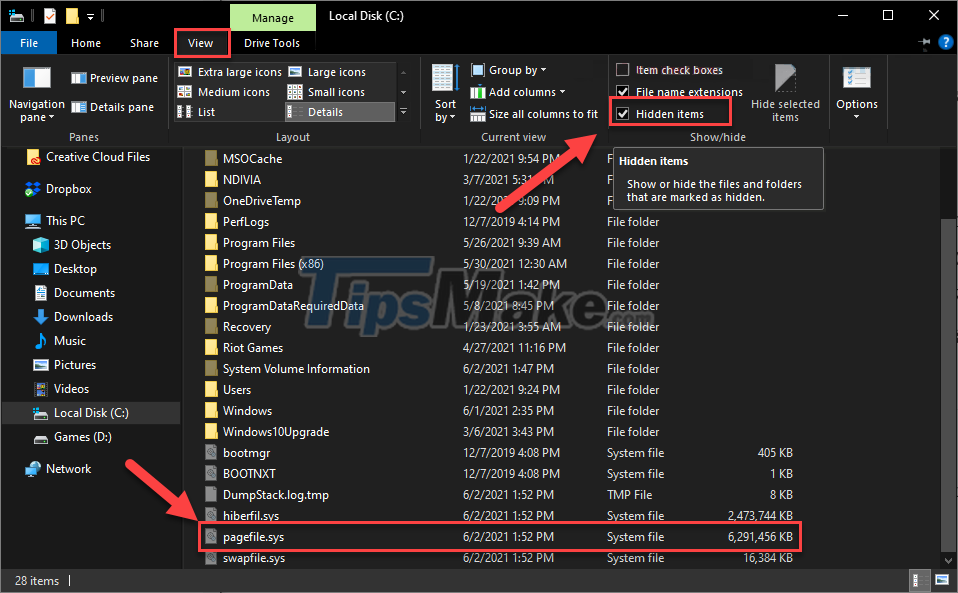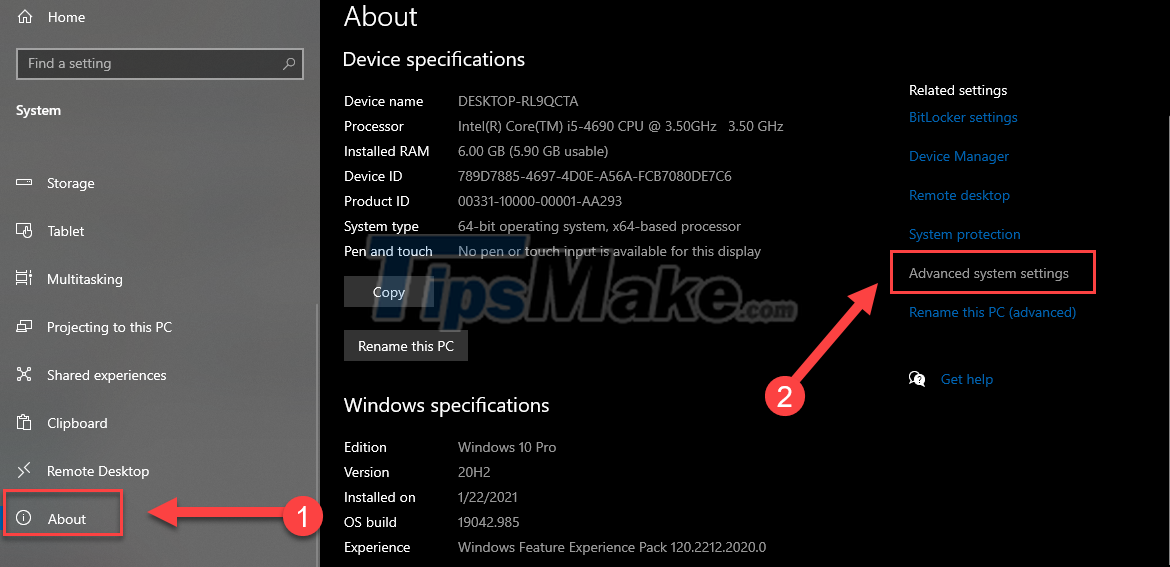How to set Pagefile.sys limit on Windows 10
If you want to set up Pagefile.sys yourself, read the article below to make sure your computer works safely.
What is Pagefile?
Pagefile is a hidden system file on your hard drive, used to compensate for low amounts of RAM. Pagefile acts as an extension to RAM. Data that cannot be processed in RAM will be stored in the Pagefile and wait until the RAM has enough free space. This is also where the operating system automatically places files and logs in case the system crashes.
Pagefile is hidden in the system drive, you can see it when you choose to show Hidden items.

And that is the function of the Pagefile, now let's learn about the optimal size of a Pagefile.
How big is the Pagefile.sys size?
Since the Pagefile is directly linked to the system RAM, its size is managed by Windows itself. If the PC has a lot of RAM, the Pagefile is not even used. In the case of a PC with little RAM, the Pagefile size can be significantly large and take up the hard drive.
Therefore, to set the appropriate Pagefile size for your computer, please refer to the following criteria:
- The PC should have a minimum Pagefile size equal to the RAM, plus 257 MB. That is, if your system RAM is 8G, then the Pagefile size should be at 8449 MB or more.
- If you want the Pagefile to be maximized, its size should only be 3 times the amount of system RAM. If its value is set too large, it will take up a lot of storage space on your computer.
In addition, we also have a way to determine exactly how much Pagefile is right for your PC:
Step 1: Open your computer as usual, then run all the programs and applications you regularly use to put the PC into the most active state.
Step 2: You find 'performance monitor' in the search bar and open this application.

Step 3: When the window appears, in the left pane, open Monitoring Tools >> Performance Monitor.

Step 4: In the chart on the right, right-click on any empty space and select Add Counter…

Step 5: In the Available counters section, expand Paging File >> % Usage >> Add at the bottom.

Step 6: Make sure counter % Usage has been added to the right pane, now click OK.

Step 7: Now, you will see the parameters appear below the chart, shown in MB. In my case the number was around 1700MB.
Based on that to find your Pagefile size, it needs to be larger than the space being used.
And the next problem you need to find out is: how to resize Pagefile?
How to set Pagefile size limit in Windows 10
Step 1: You press Windows + I to open Settings, navigate to System.

Step 2: Scroll down the menu to select About >> Advanced system settings.

Step 3: In the window that appears, switch to the Advanced tab, then select Settings… under Performance.

Step 4: In the Performance Options window, continue to switch to the Advanced >> Change tab.

Step 5: You uncheck the box Automatically manage paging file size for all drives.

Step 6: Check the Custom size box and enter the minimum and maximum parameters for the desired Pagefile size.

Step 7: Finally press Set and OK. Then restart your computer for the change to take effect.

For an important PC and requires powerful processing power, you should equip more RAM, it will help process data much faster than a hard drive. But for computers that do not require too much, you just need to install the Pagefile as instructed above.
You should read it
- Instructions for changing Pagefile.sys size and location on Windows
- Clean up traces of Pagefile every time you turn off your Windows 10 computer
- What is Pagefile.sys and should it be disabled?
- Instructions for changing Pagefile size and position on Windows
- How to manage Pagefile virtual memory in Windows 10
- What is Swapfile.sys, how to delete Swapfile.sys?
- What is a DLL file, and how does this file work?
- What is Hiberfil.sys? How to delete Hiberfil.sys?
May be interested
- Limit download speed for IDM - Limit download speed on IDM
 limit download speed by internet download manager helps you control your internet speed more efficiently. you have both an internet connection speed to access the network and an effective file download speed.
limit download speed by internet download manager helps you control your internet speed more efficiently. you have both an internet connection speed to access the network and an effective file download speed. - How to limit download speed of IDM
 speaking of speeding up downloads, everyone knows internet download manager (idm). this is the most famous and most popular download support application in the world today. however, sometimes not everything is perfect, for example, if it takes up the entire bandwidth if you don't have reasonable adjustments.
speaking of speeding up downloads, everyone knows internet download manager (idm). this is the most famous and most popular download support application in the world today. however, sometimes not everything is perfect, for example, if it takes up the entire bandwidth if you don't have reasonable adjustments. - How to Turn Off Headphone Volume Limit Warning on iPhone
 iphone has a speaker volume limit setting to control the sound. however, in some situations you need to increase the volume on your iphone to be able to hear the content.
iphone has a speaker volume limit setting to control the sound. however, in some situations you need to increase the volume on your iphone to be able to hear the content. - How to set Windows Updates download bandwidth limit in Windows 10
 in the newly released windows 10 creators update, microsoft allows users to control the upload and download bandwidth of windows update. with this update, you can set download bandwidth limits, make sure windows update does not use too much data with downloads in the background.
in the newly released windows 10 creators update, microsoft allows users to control the upload and download bandwidth of windows update. with this update, you can set download bandwidth limits, make sure windows update does not use too much data with downloads in the background. - How to Use Limit Breaker in Anime Adventures
 with the limit break option, you can easily maximize the potential of your best units in anime adventures. here's how to use limit breakers in anime adventures.
with the limit break option, you can easily maximize the potential of your best units in anime adventures. here's how to use limit breakers in anime adventures. - Instructions for limiting iPhone speaker volume
 ios 18.2 brings an option to limit iphone speaker volume. users can adjust how loud their iphone speakers can play songs, videos, and other media.
ios 18.2 brings an option to limit iphone speaker volume. users can adjust how loud their iphone speakers can play songs, videos, and other media. - The time-limited feature on Apple's iOS 12 is hacked by a 7-year-old child
 a parent shared on the reddit forum that his 7-year-old son has successfully hacked the time limit for using apple apps.
a parent shared on the reddit forum that his 7-year-old son has successfully hacked the time limit for using apple apps. - How to remove the 40 minute limit on Zoom for unlimited use
 zoom has a policy to support teachers by removing the 40-minute limit when they log in zoom by email with the domain @ edu.vn. this article will guide teachers to remove the 40 minute limit on zoom so that they can teach unlimited on zoom.
zoom has a policy to support teachers by removing the 40-minute limit when they log in zoom by email with the domain @ edu.vn. this article will guide teachers to remove the 40 minute limit on zoom so that they can teach unlimited on zoom. - How to prevent laptop battery from charging past 80% on Windows 11
 while windows 11 doesn't include any direct options to limit battery charge, you can still do so using manufacturer-specific tools or bios settings.
while windows 11 doesn't include any direct options to limit battery charge, you can still do so using manufacturer-specific tools or bios settings. - Windows Phone Store increases the limit of downloading apps by 3G / 4G
 according to the wpcentral site, in some markets microsoft has now begun to apply a policy to increase the download capacity limit of a windows phone store application when using 3g / 4g networks.
according to the wpcentral site, in some markets microsoft has now begun to apply a policy to increase the download capacity limit of a windows phone store application when using 3g / 4g networks.










 What is WinSxS? How to clean the WinSxS folder on Windows 10
What is WinSxS? How to clean the WinSxS folder on Windows 10 How to delete System Restore Points in Windows 10
How to delete System Restore Points in Windows 10 What is Updating your System? How to turn off automatic Windows 10 update very easily
What is Updating your System? How to turn off automatic Windows 10 update very easily Fix 'System Thread Exception Not Handled' error on Windows 10
Fix 'System Thread Exception Not Handled' error on Windows 10 How to split screen on Windows 10
How to split screen on Windows 10 How to uninstall old drivers on Windows 10
How to uninstall old drivers on Windows 10